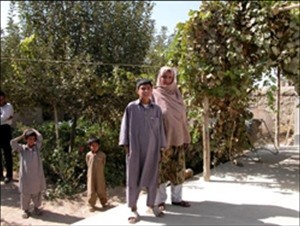Home » Reports & Data » Progress » Transforming Lives » Women Participate in Improved Irrigation Practices

12-year-old Omid, standing among the lush garden hidden behind the mud walls of the family compound in the Charasiab district of Kabul.
Matt Herrick
USAID introduces new technology to 56 Afghan families to fight food shortages
1 DECEMBER 2003 | CHARASIAB DISTRICT, KABUL
“Mom picks the tomatoes every other day and I fill the tank.”
For those families without access to any other means of irrigation and struggling through food shortages, USAID has introduced drip irrigation to Afghanistan. Four local NGO partners selected 56 families, including Omid’s, in the provinces of Kabul and Parwan to participate in the program.
Over one-third of the families selected for this project relied solely on drip systems to produce harvestable and consumable crops. Women and children were introduced to this new system because they are more likely to have flexible time during the day to cultivate the garden. As a result, the drip projects have also increased gender awareness through vocational exercises. Women were invited to attend training sessions delivered by local NGO partners and drip irrigation experts.
Nearly 20 families or 160 people now have a reliable source of irrigation. And unlike traditional irrigation—flood it and forget it—drip systems will improve and expand with greater awareness, saving water supplies and boosting family food security. Although the family garden is not large - usually a plot varies from 120 to 400 square meters - the garden cuts food shortages dramatically while improving nutrition with vitamin-rich crops.







Comment
Make a general inquiry or suggest an improvement.